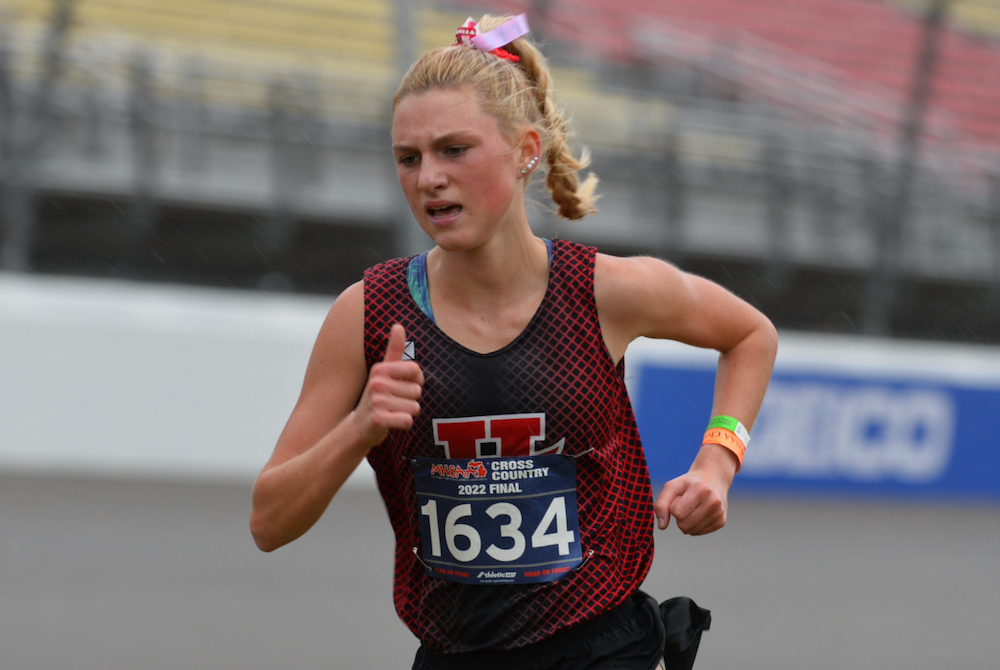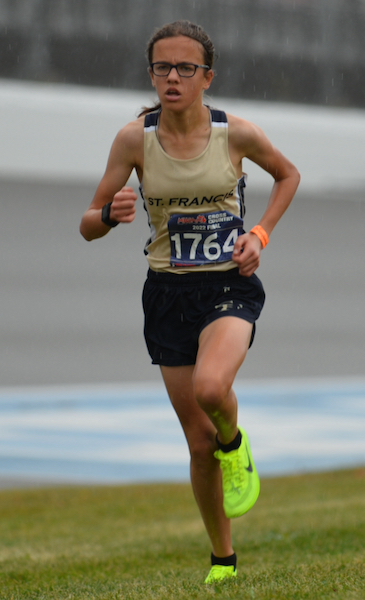
Breckenridge Star Finishes Historic Run
November 2, 2013
By Bill Khan
Special to Second Half
BROOKLYN — Kirsten Olling's greatest competition wasn't on the course at Michigan International Speedway on Saturday.
The names she was chasing were names from the past, some of the greatest runners in the history of Michigan cross country.
Olling put her name among the elite by winning her fourth MHSAA Finals championship, doing so in a Lower Peninsula Division 4-record time of 17:44.9.
She became only the third girl to win four outright MHSAA championships and fifth to win four races at the LP Finals. Carrie Gould of Burton Bendle and Flint Powers Catholic won four in a row from 1992-95 and Katie Boyles of Rochester Adams did so from 1997-2000. Theresa Padilla of Camden-Frontier (1984-87) and Valarie Ambrose of Riverview Gabriel Richard (1981-84) won four races in an era in which there were team and individual races, but didn't always have the best overall time in their classes.
"It's amazing," Olling said. "Today was my last high school race, so it's the best thing ever to know I'm out there now."
Barring a disaster — and they happened to two other runners in the past who were going for their fourth titles — Olling was going to join Gould and Boyles. Her focus on Saturday was to take down the Division 4 course record of 17:54.9 set by Marissa Treece of Maple City Glen Lake in 2006. Treece and Olling are the only Division 4 girls to break 18 minutes at the MHSAA Finals, both doing so twice.
"My main goal for today's race was time," Olling said. "With me, that's mostly my own competition — how fast can I do this? That was my main goal for this season, to get the course record."
The Division 4 girls race was the first of eight on a course that was soaked by rain overnight and early in the morning. It didn't seem to slow up Olling, who wouldn't let the conditions become an excuse.
"I was so nervous, but I was saying to myself, 'OK, no matter what the conditions are, I have to do this,'" she said. "It doesn't matter if I have to kill myself to do it; I've got to do it."
Olling hasn't had a close finish in any of her four championship races. This one was the largest gap, as Tessa Fornari of Waterford Our Lady of the Lakes took second trailing by 57.8 seconds. It was the largest margin ever in a LP Division 4 race, eclipsing Treece's 57.4-second victory in 2006.
Olling would've loved to add a team championship to her resume, but Breckenridge came up just short. Beal City won with 120 points, followed by Breckenridge with 136 and Bear Lake with 158.
Beal City flew under the radar all season, not even receiving honorable mention in either of the two state rankings. It was a puzzling slight, considering Beal City finished fourth last season, 10th the previous year and had made the top 10 four of the last seven years. The Aggies returned their top three runners and four of the top five from a team that was 42 points out of first place last season.
Sophomore Hannah Steffke led Beal City, placing 10th overall in 19:27.0. Also scoring for the Aggies were senior Hannah Neyer (19:57.0), junior Emily Steffke (20:12.5), freshman Ariel Salter (20:52.6) and freshman Brenda Faber (21:04.2). Faber's finish was a huge key for the Aggies, as she took 44th among team runners. Last year, the Aggies' No. 5 runner was 76th among team runners. The top four Aggies pretty much fell in line with last year's lineup.
PHOTO: Breckenridge's Kirsten Olling sprints down the stretch Saturday on the way to her fourth MHSAA individual cross country championship (Click to see more from RunMichigan.com)

Jazwinski Brings Hart Individual Title as St. Francis Moves to Front of Team Pack
November 5, 2022
BROOKLYN – Cross country races can be won between the ears before runners ever step foot onto the course.
Attitudes were tested as rain began to descend on Michigan International Speedway and the wind picked up just before the start of the MHSAA Lower Peninsula Division 3 girls race late Saturday morning.
Hart sophomore Jessica Jazwinski was loving life as she prepared to race.
“As a distance runner, I really try to love the wind,” she said. “Distance running and cross country is just a tough sport. The wind just adds to it — and the rain, too. It’s super fun.
“I was just thinking these conditions are just gonna feed my great race. This is real cross country. Yeah!”
Jazwinski overcame the elements to run the fifth-fastest Division 3 time ever, winning with a time of 17:36.70. She has two of the top-five times in Division 3 Finals history, having run 17:31.4 to place third last year.
“Today my race plan was just to go out hard and try to hold on to my pace,” she said. “I feel like I tried to race a lot like Steve Prefontaine, just go out and hold on.”
 Lansing Catholic senior Hannah Pricco was second in 18:17.59, Onsted sophomore Emmry Ross was third in 18:20.96 and Hart junior Alyson Ens was fourth in 18:28.52.
Lansing Catholic senior Hannah Pricco was second in 18:17.59, Onsted sophomore Emmry Ross was third in 18:20.96 and Hart junior Alyson Ens was fourth in 18:28.52.
“I love having great teammates to work with and encourage each other,” Jazwinski said. “We really try to encourage each other so much throughout the races. Throughout this year, some races she’s been a minute behind me, some races she’s been five seconds. I don’t want her to ever beat me, so that pushes me so much. I know she’s trying to race me and get up there with me.”
The only downer for Hart was having its string of Division 3 championships end at five with a fourth-place finish. Hart had two runners in the top four, but its No. 3 runner was 68th.
“I would totally trade my individual title for a team title,” Jazwinski said.
Traverse City St. Francis emerged from a close battle to win its first title since 2016 with 134 points. Pewamo-Westphalia was second with 142 and Lansing Catholic third with 165.
Sophomore Betsy Skendzel led St. Francis, placing seventh in 18:48.33. Completing the team score were senior Sophia Rhein in 26th (19:43.27), sophomore Grace Slocum in 33rd (20:07.95), junior Rylee Duffing in 60th (20:44.82) and junior Margot Hagerty in 63rd (20:45.78).
Lansing Catholic had three place in the top 10, but didn’t get another finisher until 103rd.
PHOTOS (Top) Hart’s Jessica Jazwinski pushes toward the finish during Saturday’s LPD3 Final. (Middle) Traverse City St. Francis’ Betsy Skendzel leads the way for the eventual team champion. (Click for more from Dave McCauley/RunMichigan.com.)

